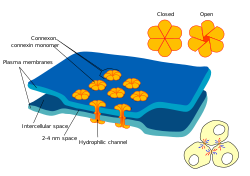Electrical synapse
| Electrical synapse | |
|---|---|

Diagram of a gap junction
|
|
| Identifiers | |
| TH | H1.00.01.1.02024 |
| FMA | 67130 |
|
Anatomical terminology
[]
|
|
An electrical synapse is a mechanical and electrically conductive link between two neighboring neurons that is formed at a narrow gap between the pre- and postsynaptic neurons known as a gap junction. At gap junctions, such cells approach within about 3.5 nm of each other, a much shorter distance than the 20- to 40-nanometer distance that separates cells at chemical synapse. In many animals, electrical synapse-based systems co-exist with chemical synapses.
Compared to chemical synapses, electrical synapses conduct nerve impulses faster, but, unlike chemical synapses, they lack gain—the signal in the postsynaptic neuron is the same or smaller than that of the originating neuron. Electrical synapses are often found in neural systems that require the fastest possible response, such as defensive reflexes. An important characteristic of electrical synapses is that they are mostly bidirectional (allow impulse transmission in either direction).
Each gap junction (aka nexus junction) contains numerous gap junction channels that cross the membranes of both cells. With a lumen diameter of about 1.2 to 2.0 nm, the pore of a gap junction channel is wide enough to allow ions and even medium-size molecules like signaling molecules to flow from one cell to the next, thereby connecting the two cells' cytoplasm. Thus when the membrane potential of one cell changes, ions may move through from one cell to the next, carrying positive charge with them and depolarizing the postsynaptic cell.
Gap junction funnels are composed of two hemi-channels called connexons in vertebrates, one contributed by each cell at the synapse. Connexons are formed by six 7.5 nm long, four-pass membrane-spanning protein subunits called connexins, which may be identical or slightly different from one another.
...
Wikipedia
